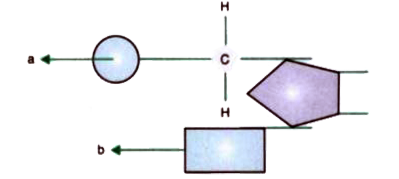Complete Solutions to PRACTICE QUESTIONS (VERY SHORT ANSWER TYPE QUESTIONS of chapter MOLECULAR BASIS OF INHERITANCE of Class 12 book with complete answers and questions
| Class 12 | BIOLOGY |
| Chapter | MOLECULAR BASIS OF INHERITANCE |
| SRIJAN | PRACTICE QUESTIONS (VERY SHORT ANSWER TYPE QUESTIONS |
| Number Of Questions | 37 |
| Academic Year | 2023-24 |
Name the organism in which RNA serves as a genetic material.
01:20View SolutionWhen does DNA replicate in cell cycle of eukaryotes?
01:04View SolutionWho first identified DNA and what was the name given to it?
01:44View SolutionWhich enzyme joins the short pieces in lagging strands during DNA synthesis?
01:19View SolutionWhat are retroviruses?
03:06View SolutionHow do the tRNA molecules appear in
Two dimensional, and05:04View SolutionMention the contribution of genetic maps in human genome project.
01:53View SolutionWhat forms the backbone of a polynucleotide strand of a nucleic acid?
02:56View SolutionName the chromosomes having maximum and least number of genes respectively.
01:34View SolutionName the enzyme that can break and reseal the strands of DNA.
01:46View SolutionWhat conclusion is drawn from the ‘Blender experiment’ performed by Hershey and Chase?
02:15View SolutionIn which direction is the new strand of DNA synthesised during replication?
02:07View SolutionInsertion or delection of a single base causes
06:06View SolutionMention the role of the codons AUG and UGA during protein synthesis.
02:31View SolutionIn which direction is the leading strand synthesised during DNA synthesis?
03:27View SolutionWhat is the base pairing pattern of DNA?
01:53View SolutionName the enzyme which can do proof reading during DNA synthesis in bacterial cells.
02:17View SolutionName the initiation codon for protein synthesis. Name the amino acid it codes for.
01:24View SolutionWhat is the function of amino-acyl-tRNA synthetase?
01:23View SolutionWhat is the function of ligase?
01:31View SolutionName the process in which the unwanted mRNA regions are removed and the wanted regions are joined
01:23View SolutionMention the role of DNA polymerase other than polymerising deoxyribonucleotides during DNA synthesis.
01:57View SolutionWhat is nucleosome?
02:03View SolutionGive chemical name for thymine.
01:39View SolutionName the technique used in making copies of a specific segment of DNA
01:07View SolutionDue to an error during transcription, ATG of DNA formed UAG in mRNA. What would happen to the polypeptide chain during translation by this changed mRNA?
01:41View SolutionWhile an mRNA strand is being translated in the ribosome subunit, the triplets in sequence were UAC and UAG. One of them. codes for tyrosine. What is the significance of the other? Pick out the codon and specify.
01:27View SolutionName the components ‘a’ and ‘b’ in the nucleotide with a purine below
 02:47View Solution
02:47View SolutionName the technique used for separating DNA fragments in the laboratory.
03:08View SolutionWhy hnRNA' is required to undergo splicing
01:13View SolutionMention the two addition processing which hnRNA needs to undergo after splicing so as to become functional.
02:21View SolutionMention two functions of the codon AUG.
01:11View SolutionWhy is the enzyme cellulose used for isolating genetic material from plant cells but not for animal cells?
01:40View SolutionHow is the action of exonuclease different from that of endonuclease ?
02:55View SolutionGive one word - One codon codes for only one amino acid. The genetic code is ....
01:35View SolutionName the positively charged proteins around which the negatively charged DNA is wrapped.
01:16View SolutionName the two basic amino acids that provide positive charges to histone proteins.
01:09View Solution
PRACTICE QUESTIONS (VERY SHORT ANSWER TYPE QUESTIONS questions and complete solutions for chapter MOLECULAR BASIS OF INHERITANCE of SRIJAN BIOLOGY (ENGLISH) of Class 12
All Exercises from SRIJAN Class 12 BIOLOGY MOLECULAR BASIS OF INHERITANCE
- ILLUSTRATIVE QUESTIONS
- MCQ
- MCQ (Assertion and Reason)
- MCQ (Choose the odd one out of the following)
- MCQ (Figure based questions)
- MCQ (Fill in the blanks)
- MCQ (Match the following)
- MCQ (Source Based Questions)
- OBJECTIVE TYPE QUESTIONS (ASSERTION AND REASON TYPE QUESTION )
- OBJECTIVE TYPE QUESTIONS (MULTIPLE CHOICE QUESTION (MCQ)
- PRACTICE QUESTIONS ( LONG ANSWER TYPE QUESTIONS )
- PRACTICE QUESTIONS (SHORT ANSWER TYPE -II)
- PRACTICE QUESTIONS (SHORT ANSWER TYPE)
- PRACTICE QUESTIONS (VERY SHORT ANSWER TYPE QUESTIONS
- PREVIOUS YEARS BOARD PAPER QUESTIONS ( LONG ANSWER TYPE QUESTIONS)
- PREVIOUS YEARS BOARD PAPER QUESTIONS ( SHORT ANSWER TYPE-II)
- PREVIOUS YEARS BOARD PAPER QUESTIONS ( VERY SHORT ANSWER TYPE QUESTIONS)
- REVIEW QUESTIONS
